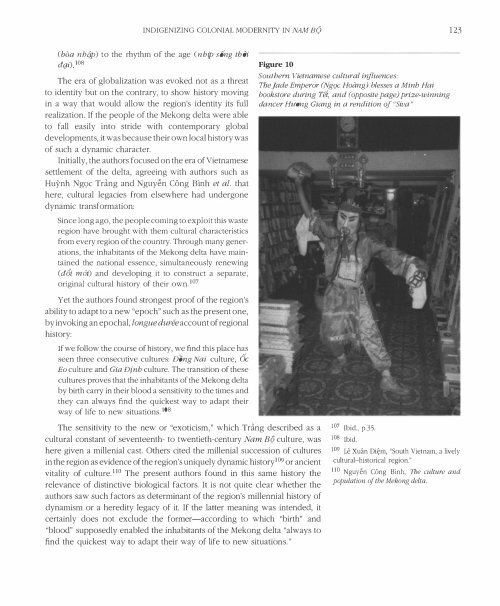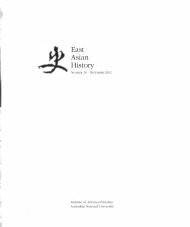(Philip Taylor) (PDF 3.1MB) - ANU
(Philip Taylor) (PDF 3.1MB) - ANU
(Philip Taylor) (PDF 3.1MB) - ANU
Create successful ePaper yourself
Turn your PDF publications into a flip-book with our unique Google optimized e-Paper software.
INDIGENIZING COLONIAL MODERNITY IN NAM EO<br />
123<br />
(bOa nh[}p) to the rhythm of the age (nhfp s6ng th Oi<br />
d q i) I08 Figure 10<br />
The era of globalization was evoked not as a threat<br />
Southern Vietnamese cultural influences:<br />
The Jade Emperor (NgQC Hoang) blesses a Minh Hai<br />
to identity but on the contrary, to show history moving bookstore during Tel, and (opposite page) prize-winning<br />
in a way that would allow the region's identity its full dancer HUrYng Giang in a rendition of "Siva "<br />
realization. If the people of the Mekong delta were able<br />
to fall easily into stride with contemporary global<br />
developments, it was because their own local history was<br />
of such a dynamic character.<br />
Initially, the authors focused on the era of Vietnamese<br />
settlement of the delta, agreeing with authors such as<br />
Huynh NgQc Trang and Nguyen C6ng Blnh et al. that<br />
here, cultural legacies from elsewhere had undergone<br />
dynamic transformation:<br />
Since long ago, the people coming to exploit this waste<br />
region have brought with them cultural characteristics<br />
from every region of the country. Through many generations,<br />
the inhabitants of the Mekong delta have maintained<br />
the national essence, simultaneously renewing<br />
(dtJi mCti) and developing it to construct a separate,<br />
original cultural history of their own. 1 07<br />
Yet the authors found strongest proof of the region's<br />
ability to adapt to a new "epoch" such as the present one,<br />
by invoking an epochal, longue duree account of regional<br />
history:<br />
If we follow the course of history, we find this place has<br />
seen three consecutive cultures: Dong Nai culture, 6c<br />
Eo culture and Gia Dtnh culture. The transition of these<br />
cultures proves that the inhabitants of the Mekong delta<br />
by birth carry in their blood a sensitivity to the times and<br />
they can always find the quickest way to adapt their<br />
way of life to new situations. lOS<br />
The sensitivity to the new or "exoticism," which Trang described as a<br />
cultural constant of seventeenth- to twentieth-century Na m Br') culture, was<br />
here given a millenial cast. Others cited the millenial succession of cultures<br />
in the region as evidence of the region's uniquely dynamic history109 or ancient<br />
vitality of culture.11o The present authors found in this same history the<br />
relevance of distinctive biological factors. It is not quite clear whether the<br />
authors saw such factors as determinant of the region's millennial history of<br />
dynamism or a heredity legacy of it. If the latter meaning was intended, it<br />
certainly does not exclude the former-according to which "birth" and<br />
"blood" supposedly enabled the inhabitants of the Mekong delta "always to<br />
find the quickest way to adapt their way of life to new situations."<br />
107 Ibid., p.35.<br />
108 Ibid.<br />
109 Le Xuan Dim, "South Vietnam, a lively<br />
cultural-historical region."<br />
110 Nguyn C6ng Blnh, The culture and<br />
population of the Mekong delta.
















